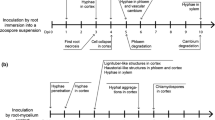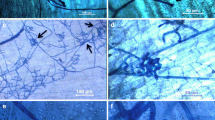Summary
Zea mays is a non-host ofPhytophthora cinnamomi; plants survive contact with this fungus both in the field and in pot trials. TheZ. mays-P. cinnamomi interaction has been studied by light and electron microscopy. In the epidermal layer, fungal hyphae grow intercellularly through the middle lamella. This is always the case for the first hyphal contact with any cell. Hyphae making second or subsequent contacts with a cell grow preferentially between the cell wall and plasma membrane of the infected cell rather than through the middle lamella.
Papillae (callose deposits) are formed in response to some, but not all, regions of contact between the plant cell and the hypha. They do not completely encase the hypha and do not stop hyphal growth. The plasma membrane-cell wall interface of the host cell must be intact for effective papilla formation, as papillae are rarely formed when the hyphae grow between the plasma membrane and the cell wall.
Similar content being viewed by others
References
Aist, J. R., 1983: Structural responses as resistance mechanisms. In: The dynamics of host defence (Bailey, J. A., Deverall, B. J., eds.), pp. 33–65. Sydney: Academic Press.
Allen F. H. E., Friend, J., 1983: Resistance of potato tubers to infection byPhytophthora infestans: a structural study of haustorial encasement. Physiol. Plant Pathol.22, 285–292.
Byrt, P., Grant, B., 1979: The conditions governing zoospore production in axenic cultures ofPhytophthora cinnamomi Rands. Aust. J. Bot.27, 103–116.
Eschrich, W., Currier, H. B., 1964: Identification of callose by its diachrome and fluorochrome reactions. Stain Technol.39, 303–307.
Hachler, H., Hohl, H. R., 1984: Temporal and spatial distribution patterns of collar and papillae wall appositions in resistant and susceptible tuber tissue ofSolanum tuberosum infected byPhytophthora infestans. Physiol. Plant Pathol.24, 107–118.
Hanchey, P., Wheeler, H., 1971: Pathological changes in ultrastructure: Tobacco roots infected withPhytophthora parasitica var.nicotianae. Phytopathology61, 33–39.
Heath, M. C., 1980: Reactions of nonsuscepts to fungal pathogens. Ann. Rev. Phytopathol.18, 211–236.
Hinch, J. M., Clarke, A. E., 1982: Callose formation inZea mays as a response to infection withPhytophthora cinnamomi. Physiol. Plant Pathol.21, 113–124.
—,Weste, G. M., 1979: Behaviour ofPhytophthora cinnamomi zoospores on roots of Australian forest species. Aust. J. Bot.27, 679–691.
Hohl, H. R., Stossel, P., Hachler, H., 1980: Papilla formation and partial inhibition of fungal glucanases by phytoalexins in thePhytophthora infestans-Solanum tuberosum system. Ann. Phytopathol.12, 353–362.
—,Suter, E., 1976: Host-parasite interfaces in a resistant and a susceptible cultivar ofSolanum tuberosum inoculated withPhytophthora infestans leaf tissue. Can. J. Bot.54, 1956–1970.
MacWithey, H. S., 1965: Factors affecting the prevalence of black rot disease of sugar beets. Phytopathology55, 1066.
Mourichon, X., Salle, G., 1981: étude ultrastructurale des relations hÔte-parasite au cours de l'infection des pommes par lePhytophthora cactorum. Can. J. Bot.59, 251–263.
Porter, J. R.,Shaw, D. S., 1978: Aggregation ofPhytophthora dreschleri zoospores; pattern analysis suggests a taxis. Trans. Br. Mycol. Soc.71 (3), 1978.
Smith, M. M., McCully, M. E., 1978: Enhancing aniline blue fluorescent staining of cell wall structures. Stain Tech.53, 79–85.
Stossel, P., Lazarovits, G., Ward, E. W. B., 1981: Electron microscope study of race-specific and age related resistant and susceptible reactions of soybeans toPhytophthora megasperma var.sojae. Phytopathology71, 617–623.
Tippett, J., Holland, A. A., Marks, G. C., O'Brien, T. P., 1976: Penetration ofPhytophthora cinnamomi into disease tolerant and susceptible eucalypts. Arch. Microbiol.108, 231–242.
—,Malajczuk, N., 1979: Interaction ofPhytophthora cinnamomi and a resistant host,Acacia pulchella. Phytopathol.69, 764–772.
—,O'Brien, T., Holland, A. A., 1977: Ultrastructural changes in eucalypt roots caused byPhytophthora cinnamomi. Physiol. Plant Pathol.11 (3), 279–286.
Wetherbee, R., Hinch, J. M., Bonig, I., Clarke, A. E., 1984: Response ofZea mays roots to infection withPhytophthora cinnamomi: II. The cortex and stele. Protoplasma126, 188–197.
Zentmyer, G. A., 1980:Phytophthora cinnamomi and the diseases it causes. Monograph No. 10, The American Phytopathological Society.
Author information
Authors and Affiliations
Rights and permissions
About this article
Cite this article
Hinch, J.M., Wetherbee, R., Mallett, J.E. et al. Response ofZea mays roots to infection withPhytophthora cinnamomi . Protoplasma 126, 178–187 (1985). https://doi.org/10.1007/BF01281793
Received:
Accepted:
Issue Date:
DOI: https://doi.org/10.1007/BF01281793




